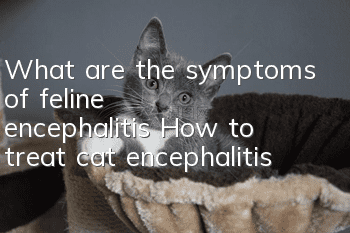What are the symptoms of feline encephalitis? How to treat cat encephalitis

Encephalitis generally refers to inflammation of the meninges and brain parenchyma caused by infection or toxic factors. Encephalitis can occur in cats of different ages and is mostly acute or subacute. It can be divided into purulent encephalitis and non-suppurative encephalitis according to the nature of the lesions.
1. Causes of Feline Encephalitis
⒈Non-suppurative encephalitis
Usually caused by infectious diseases, it occurs most often during the onset of illness or after recovery. It can also be caused by poisoning by bacterial toxins or certain chemicals (such as lead, etc.).
⒉Pyogenic encephalitis
It is mostly caused by post-traumatic bacterial infection or spread of suppurative lesions in nearby areas; it can also be caused by sepsis and thrombosis (but less common); it is occasionally caused by parasitic larvae straying into the brain by mistake.
2. Analysis of symptoms of encephalitis in cats
There are many factors that can cause encephalitis in cats, and no matter what the cause is, the mortality rate of encephalitis is very high. Even if the disease is cured, there will be sequelae. Let’s analyze the symptoms of cats suffering from encephalitis.
Symptoms are closely related to the location and size of the lesion and the animal’s personality. Usually changes in intracranial pressure and blood circulation disorders lead to the occurrence of brain symptoms, and then various changes in the respiratory system, circulatory system, digestive system, and motor system. Nervous symptoms develop from the excitement phase to the depression phase. As the disease progresses, due to disturbance of consciousness, the animal does not recognize its owner, screams when touching the body, or bites, and its behavior is obviously abnormal. In addition, the pupils are constricted, the conjunctiva is congested, the gait is unsteady, and sometimes epileptic seizures and circular movements occur. The vision gradually decreases, and then becomes blind and enters a comatose state.
Suppurative encephalitis is accompanied by high fever, while simple encephalitis is usually afebrile and has a variable appetite.
3. Diagnosis and treatment of feline encephalitis
Feline encephalitis is a terrible disease, and even if it recovers, it will have lifelong sequelae. In order to prevent the condition from getting worse, symptomatic treatment and antiviral treatment are measures that every doctor will take. Accurate diagnosis is the key to treating the disease. Let’s learn about the diagnosis and treatment of feline encephalitis.
1. Diagnosis
In addition to diagnosis based on general brain symptoms and focal symptoms, blood and cerebrospinal fluid tests can be performed. Blood tests mainly showed an increase in neutrophils and left-shifted nuclei. Cerebrospinal fluid examination is of great significance. Due to the increase in intracranial pressure during puncture, turbid cerebrospinal fluid is likely to flow out, in which the number of proteins and cells increases; in the case of purulent encephalitis, in addition to an increase in neutrophils in the cerebrospinal fluid , as well as pathogenic microorganisms.
2. Treatment
Regardless of the cause of encephalitis, the mortality rate is generally high, and occasional recovery may have sequelae.disease. For patients with bacterial or secondary infections, drugs that easily penetrate the blood-brain barrier (such as sulfa drugs, ampicillin, and gentamicin) can be used. If necessary, sedatives can be used, such as phenobarbital (2~5 mg/kg body weight, every day). 3 times a day, orally) or chlorpromazine (1~2mg/kg body weight, intramuscular injection). To reduce cerebral edema and reduce inflammation, prednisone 1mg/kg body weight, intramuscular injection, or 20% mannitol intravenous injection can be used.
- A cat will die if it urinates for a few days
- Should you deworm yourself or go to a pet store?
- Are cat teasers harmful to cats?
- What should I do if my cat suffers from chronic gingivitis?
- Cat's nails are cracked with a thin layer
- Cats go crazy after eating mutton
- What does cat moss on a cat’s chin look like?
- Can cats reproduce after abdominal transmission is cured?
- What exactly is the sterilization shot for female cats?
- Can I still eat unopened cat food if it has expired?



